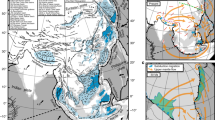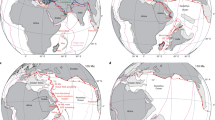Abstract
The most spectacular example of a plate convergence event on Earth is the motion of the Indian plate towards Eurasia at speeds in excess of 18 cm yr−1 (ref. 1), and the subsequent collision. Continental buoyancy usually stalls subduction shortly after collision, as is seen in most sections of the Alpine–Himalayan chain. However, in the Indian section of this chain, plate velocities were merely reduced by a factor of about three when the Indian continental margin impinged on the Eurasian trench about 50 million years ago. Plate convergence, accompanied by Eurasian indentation, persisted throughout the Cenozoic era1,2,3, suggesting that the driving forces of convergence did not vanish on continental collision. Here we estimate the density of the Greater Indian continent, after its upper crust is scraped off at the Himalayan front, and find that the continental plate is readily subductable. Using numerical models, we show that subduction of such a dense continent reduces convergence by a factor similar to that observed. In addition, an imbalance between ridge push and slab pull can develop and cause trench advance and indentation. We conclude that the subduction of the dense Indian continental slab provides a significant driving force for the current India–Asia convergence and explains the documented evolution of plate velocities following continental collision.
This is a preview of subscription content, access via your institution
Access options
Subscribe to this journal
Receive 12 print issues and online access
$259.00 per year
only $21.58 per issue
Buy this article
- Purchase on Springer Link
- Instant access to full article PDF
Prices may be subject to local taxes which are calculated during checkout



Similar content being viewed by others
References
Patriat, P. & Achache, J. India–Eurasia collision chronology has implications for crustal shortening and driving mechanism of plates. Nature 311, 615–621 (1984).
DeCelles, P. G. et al. Stratigraphy, structure, and tectonic evolution of the Himalayan fold-thrust belt in western Nepal. Tectonics 20, 487–509 (2001).
Guillot, S. et al. Reconstructing the total shortening history of the NW Himalaya. Geochem. Geophys. Geosyst. 4, 1064 (2003).
Ni, J. & Barazangi, M. Seismotectonics of the Himalayan collision zone: Geometry of the underthrusting Indian plate beneath the Himalaya. J. Geophys. Res. 89, 1147–1164 (1984).
Powell, C. M. A. & Conaghan, P. J. Plate Tectonics and Himalayas. Earth Planet. Sci. Lett. 20, 1–12 (1973).
van der Hilst, R. D., Widiyantoro, S. & Engdahl, E. R. Evidence for deep mantle circulation from global tomography. Nature 386, 578–584 (1997).
Van der Voo, R., Spakman, W. & Bijwaard, H. Tethyan subducted slabs under India. Earth Planet. Sci. Lett. 171, 7–20 (1999).
Replumaz, A., Kárason, H., van der Hilst, R. D., Besse, J. & Tapponnier, P. 4-D evolution of SE Asia’s mantle from geological reconstructions and seismic tomography. Earth Planet. Sci. Lett. 221, 103–115 (2004).
Chemenda, A. I., Burg, J. P. & Mattauer, M. Evolutionary model of the Himalaya–Tibet system: Geopoem based on new modelling, geological and geophysical data. Earth Planet. Sci. Lett. 174, 397–409 (2000).
Li, C., van der Hilst, R. D., Meltzer, A. S. & Engdahl, E. R. Subduction of the Indian lithosphere beneath the Tibetan Plateau and Burma. Earth Planet. Sci. Lett. 274, 157–168 (2008).
Gaetani, M. & Garzanti, E. Multiciclic history of the Northern Indian Continental-Margin (Northwestern Himalaya). Am. Ass. Petrol. Geol. Bull. 75, 1427–1446 (1991).
Corfield, R. I., Watts, A. B. & Searle, M. P. Subsidence history of the north Indian continental margin, Zanskar–Ladakh Himalaya, NW India. J. Geol. Soc. Lond. 162, 135–146 (2005).
Kosarev, G. et al. Seismic evidence for a detached Indian lithospheric mantle beneath Tibet. Science 283, 1306–1309 (1999).
Le Pichon, X., Fournier, M. & Jolivet, L. Kinematics, topography, shortening, and extrusion in the India–Asia collision. Tectonics 11, 1085–1098 (1992).
Mattauer, M. Intracontinental subduction, crust–mantle décollement and crustal-stacking wedge in the Himalayas and other collision belts. Geol. Soc. Lond. Spec. Publ. 19, 37–50 (1986).
Cloos, M. Lithospheric buoyancy and collisional orogenesis: Subduction of oceanic plateaus, continental margins, island arcs, spreading ridges, and seamounts. Geol. Soc. Am. Bull. 105, 715–737 (1993).
Capitanio, F. A., Morra, G. & Goes, S. Dynamic models of downgoing plate-buoyancy driven subduction: Subduction motions and energy dissipation. Earth Planet. Sci. Lett. 262, 284–297 (2007).
England, P. & McKenzie, D. A thin viscous sheet model for continental deformation. Geophys. J. R. Astron. Soc. 70, 295–321 (1982).
Tapponnier, P., Peltzer, G., Le Dain, A. Y., Armijo, R. & Cobbold, P. Propagating extrusion tectonics in Asia: New insights from simple experiments with plasticine. Geology 10, 611–616 (1982).
Müller, R. D., Sdrolias, M., Gaina, C. & Roest, W. R. Age, spreading rates, and spreading asymmetry of the world’s ocean crust. Geochem. Geophys. Geosyst. 9, Q04006 (2008).
de Sigoyer, J. et al. Dating the Indian continental subduction and collisional thickening in the northwest Himalaya: Multichronology of the Tso Morari eclogites. Geology 28, 487–490 (2000).
Klootwijk, C. T., Gee, J. S., Peirce, J. W., Smith, G. M. & McFadden, P. L. An early India–Asia contact: Paleomagnetic constraints from Ninetyeast Ridge, ODP Leg 121. Geology 20, 295–298 (1992).
Replumaz, A. & Tapponnier, P. Reconstruction of the deformed collision zone between India and Asia by backward motion of lithospheric blocks. J. Geophys. Res. 108, 2285 (2003).
Chung, S. L. et al. Diachronous uplift of the Tibetan Plateau starting 40 Myr ago. Nature 394, 769–773 (1998).
Molnar, P. & Stock, J. M. Slowing of India’s convergence with Eurasia since 20 Ma and its implications for Tibetan mantle dynamics. Tectonics 28, TC3001 (2009).
Molnar, P. & Lyon-Caen, H. Some simple physical aspect of the support, structure, and evolution of mountain belts. Geol. Soc. Am. Spec. Pap. 218, 179–207 (1988).
Müller, R. D. An Indian cheetah. Nature 449, 795–796 (2007).
Goes, S., Capitanio, F. A. & Morra, G. Evidence of lower-mantle slab penetration phases in plate motions. Nature 451, 981–984 (2008).
Gurnis, M. & Torsvik, T. H. Rapid drift of large continents during the late Precambrian and Paleozoic: Paleomagnetic constraints and dynamic models. Geology 22, 1023–1026 (1994).
Conrad, C. P. & Lithgow-Bertelloni, C. How mantle slabs drive plate tectonics. Science 298, 207–209 (2002).
Acknowledgements
This research was supported under the Australian Research Council’s Discovery Projects funding scheme to F.A.C. (DP0663258, DP0878501, DP0987374), a Swiss National Fund Assistenzprofessur to S.G. and by the EURYI Awards Scheme (Euro-horcs/ESF) with funds from the National Research Council of Italy to G.M. R. D. Müller provided the rotation pole sets. We thank C. Klootwijk, C. Faccenna, D. Giardini and T. M. Harrison for discussions and D. Arcay for comments.
Author information
Authors and Affiliations
Contributions
F.A.C. and G.M. designed and carried out the numerical models. F.A.C., G.M., S.G. and L.M. discussed the implications for continental and Indian subduction. F.A.C. and R.F.W. discussed Indian tectonics. All of the authors contributed equally to writing the paper.
Corresponding author
Ethics declarations
Competing interests
The authors declare no competing financial interests.
Supplementary information
Supplementary Information
Supplementary Information (PDF 370 kb)
Rights and permissions
About this article
Cite this article
Capitanio, F., Morra, G., Goes, S. et al. India–Asia convergence driven by the subduction of the Greater Indian continent. Nature Geosci 3, 136–139 (2010). https://doi.org/10.1038/ngeo725
Received:
Accepted:
Published:
Issue Date:
DOI: https://doi.org/10.1038/ngeo725
This article is cited by
-
Geodynamic models of Indian continental flat slab subduction with implications for the topography of the Himalaya-Tibet region
Scientific Reports (2024)
-
New constraints on Cenozoic subduction between India and Tibet
Nature Communications (2023)
-
The influence of Tethyan evolution on changes of the Earth’s past environment
Science China Earth Sciences (2023)
-
Self-replicating subduction zone initiation by polarity reversal
Communications Earth & Environment (2022)
-
Metamorphic densification can account for the missing felsic crust of the Greater Indian continent
Communications Earth & Environment (2022)



